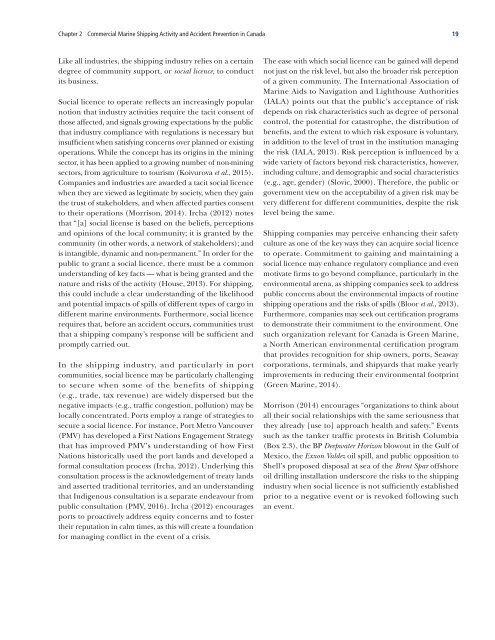Commercial Marine Shipping Accidents Understanding Risks Canada
cca_marine_shipping_risks_en_fullreport
cca_marine_shipping_risks_en_fullreport
Create successful ePaper yourself
Turn your PDF publications into a flip-book with our unique Google optimized e-Paper software.
Chapter 2 <strong>Commercial</strong> <strong>Marine</strong> <strong>Shipping</strong> Activity and Accident Prevention in <strong>Canada</strong><br />
19<br />
Like all industries, the shipping industry relies on a certain<br />
degree of community support, or social licence, to conduct<br />
its business.<br />
Social licence to operate reflects an increasingly popular<br />
notion that industry activities require the tacit consent of<br />
those affected, and signals growing expectations by the public<br />
that industry compliance with regulations is necessary but<br />
insufficient when satisfying concerns over planned or existing<br />
operations. While the concept has its origins in the mining<br />
sector, it has been applied to a growing number of non-mining<br />
sectors, from agriculture to tourism (Koivurova et al., 2015).<br />
Companies and industries are awarded a tacit social licence<br />
when they are viewed as legitimate by society, when they gain<br />
the trust of stakeholders, and when affected parties consent<br />
to their operations (Morrison, 2014). Ircha (2012) notes<br />
that “[a] social license is based on the beliefs, perceptions<br />
and opinions of the local community; it is granted by the<br />
community (in other words, a network of stakeholders); and<br />
is intangible, dynamic and non-permanent.” In order for the<br />
public to grant a social licence, there must be a common<br />
understanding of key facts — what is being granted and the<br />
nature and risks of the activity (House, 2013). For shipping,<br />
this could include a clear understanding of the likelihood<br />
and potential impacts of spills of different types of cargo in<br />
different marine environments. Furthermore, social licence<br />
requires that, before an accident occurs, communities trust<br />
that a shipping company’s response will be sufficient and<br />
promptly carried out.<br />
In the shipping industry, and particularly in port<br />
communities, social licence may be particularly challenging<br />
to secure when some of the benefits of shipping<br />
(e.g., trade, tax revenue) are widely dispersed but the<br />
negative impacts (e.g., traffic congestion, pollution) may be<br />
locally concentrated. Ports employ a range of strategies to<br />
secure a social licence. For instance, Port Metro Vancouver<br />
(PMV) has developed a First Nations Engagement Strategy<br />
that has improved PMV’s understanding of how First<br />
Nations historically used the port lands and developed a<br />
formal consultation process (Ircha, 2012). Underlying this<br />
consultation process is the acknowledgement of treaty lands<br />
and asserted traditional territories, and an understanding<br />
that Indigenous consultation is a separate endeavour from<br />
public consultation (PMV, 2016). Ircha (2012) encourages<br />
ports to proactively address equity concerns and to foster<br />
their reputation in calm times, as this will create a foundation<br />
for managing conflict in the event of a crisis.<br />
The ease with which social licence can be gained will depend<br />
not just on the risk level, but also the broader risk perception<br />
of a given community. The International Association of<br />
<strong>Marine</strong> Aids to Navigation and Lighthouse Authorities<br />
(IALA) points out that the public’s acceptance of risk<br />
depends on risk characteristics such as degree of personal<br />
control, the potential for catastrophe, the distribution of<br />
benefits, and the extent to which risk exposure is voluntary,<br />
in addition to the level of trust in the institution managing<br />
the risk (IALA, 2013). Risk perception is influenced by a<br />
wide variety of factors beyond risk characteristics, however,<br />
including culture, and demographic and social characteristics<br />
(e.g., age, gender) (Slovic, 2000). Therefore, the public or<br />
government view on the acceptability of a given risk may be<br />
very different for different communities, despite the risk<br />
level being the same.<br />
<strong>Shipping</strong> companies may perceive enhancing their safety<br />
culture as one of the key ways they can acquire social licence<br />
to operate. Commitment to gaining and maintaining a<br />
social licence may enhance regulatory compliance and even<br />
motivate firms to go beyond compliance, particularly in the<br />
environmental arena, as shipping companies seek to address<br />
public concerns about the environmental impacts of routine<br />
shipping operations and the risks of spills (Bloor et al., 2013).<br />
Furthermore, companies may seek out certification programs<br />
to demonstrate their commitment to the environment. One<br />
such organization relevant for <strong>Canada</strong> is Green <strong>Marine</strong>,<br />
a North American environmental certification program<br />
that provides recognition for ship owners, ports, Seaway<br />
corporations, terminals, and shipyards that make yearly<br />
improvements in reducing their environmental footprint<br />
(Green <strong>Marine</strong>, 2014).<br />
Morrison (2014) encourages “organizations to think about<br />
all their social relationships with the same seriousness that<br />
they already [use to] approach health and safety.” Events<br />
such as the tanker traffic protests in British Columbia<br />
(Box 2.3), the BP Deepwater Horizon blowout in the Gulf of<br />
Mexico, the Exxon Valdez oil spill, and public opposition to<br />
Shell’s proposed disposal at sea of the Brent Spar offshore<br />
oil drilling installation underscore the risks to the shipping<br />
industry when social licence is not sufficiently established<br />
prior to a negative event or is revoked following such<br />
an event.


